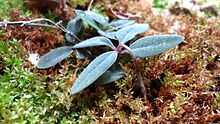Geocarpy
From Wikipedia, the free encyclopedia

Geocarpy in Spigelia genuflexa
Geocarpy is "an extremely rare means of plant reproduction",[1] in which plants produce diaspores within the soil.[2] This may occur with subterranean flowers (protogeocarpy), or from aerial flowers, which penetrate the soil after flowering (hysterocarpy). It has evolved as an effective means of ensuring a suitable environment for the plant's offspring.[2]
Geocarpy is most frequent in tropical or semi-desert areas,[2] and geocarpic species may be found in the families Araceae, Begoniaceae, Brassicaceae (Cruciferae), Callitrichaceae, Convolvulaceae, Cucurbitaceae, Fabaceae (Leguminosae), Loganiaceae, Moraceae and Rubiaceae.[2][3][4] The best-known example is the peanut, Arachis hypogaea.
References
- ↑ J. D. Skinner & Christian T. Chimimba (2005). "Order Tubulidentata". The Mammals of the Southern African Sub-region. Cambridge University Press. pp. 35–40. ISBN 9780521844185.
- ↑ 2.0 2.1 2.2 2.3 Karen van Rheede van Oudtshoorn & Margaretha W. Van Rooyen (1999). "Geocarpy". Dispersal Biology of Desert Plants. Springer. pp. 117–118. ISBN 978-3-540-64886-4.
- ↑ Suzanne I. Warwick (2010). "Brassicaceae in agriculture". In Renate Schmidt & Ian Bancroft. Genetics and Genomics of the Brassicaceae. Plant Genetics and Genomics 9. Springer. pp. 33–66. ISBN 9781441971180.
- ↑ Alex V. Popovkin, Katherine G. Mathews, José Carlos Mendes Santos, M. Carmen Molina & Lena Struwe (2011). "Spigelia genuflexa (Loganiaceae), a new geocarpic species from the Atlantic forest of northeastern Bahia, Brazil". PhytoKeys 6: 47–65. doi:10.3897/phytokeys.6.1654.
This article is issued from Wikipedia. The text is available under the Creative Commons Attribution/Share Alike; additional terms may apply for the media files.